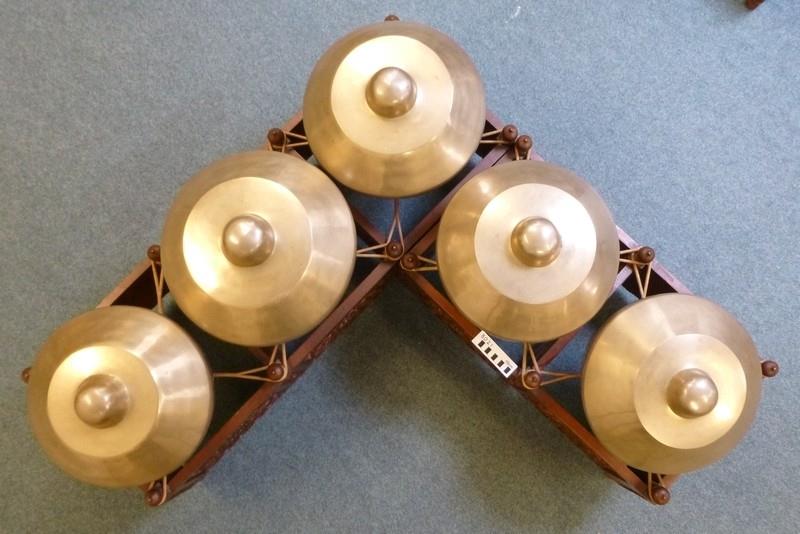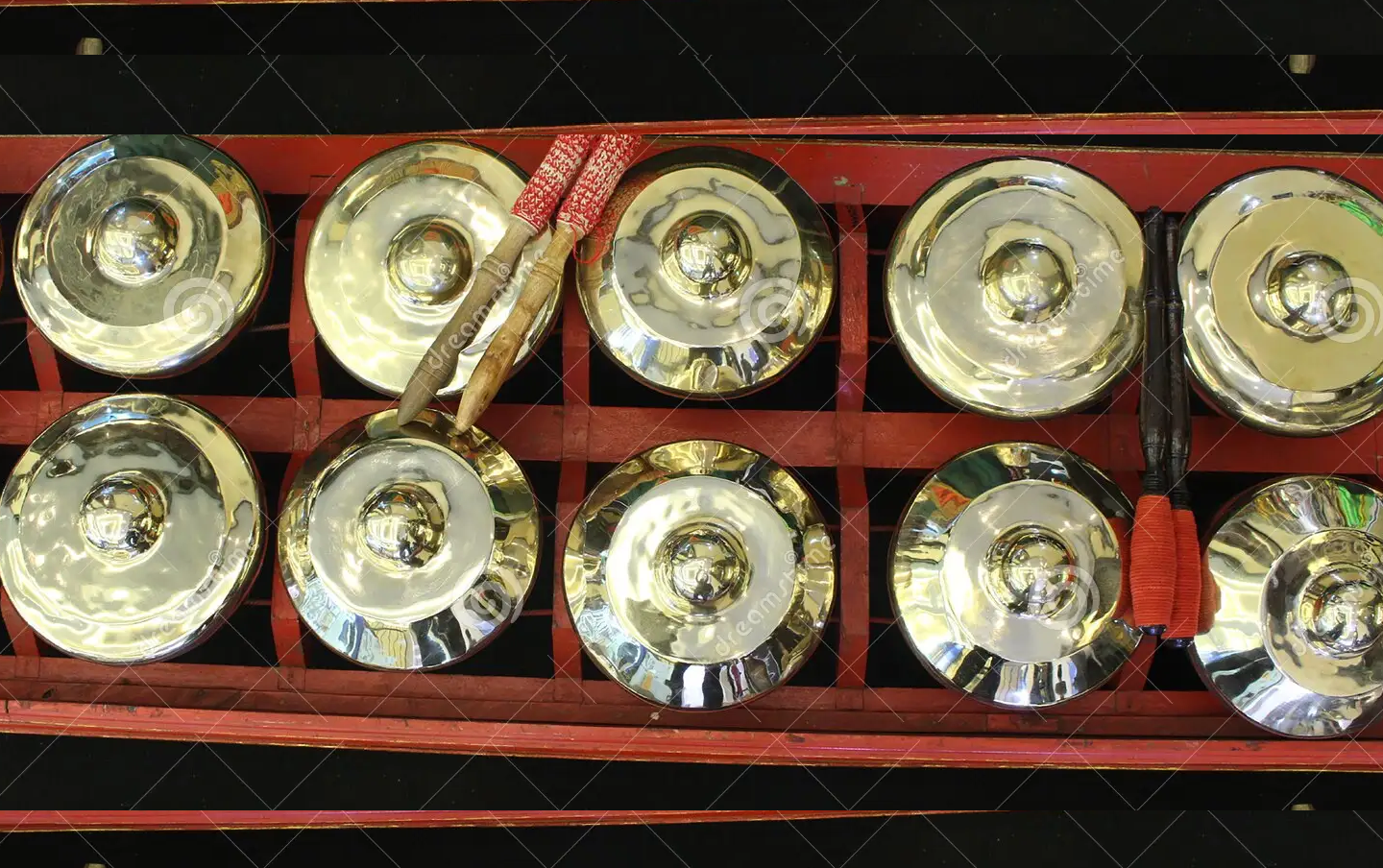Kenong
Melodic Percussions
Asia
Between 0 and 1000 AD
Video
The Kenong is a traditional musical instrument that belongs to the gong family and is primarily found in the gamelan ensembles of Indonesia, particularly in Java and Bali. It is a percussion instrument that consists of a set of large, horizontally placed, kettle-shaped gongs made of bronze or brass. The Kenong is known for its deep, resonant sound, which provides a structural backbone to gamelan compositions by marking the major divisions of a musical piece.
The Kenong is played with a padded wooden mallet, striking its raised boss (the central, dome-shaped part of the gong) to produce a clear and sustained tone. The number of Kenongs in a set varies depending on the type of gamelan ensemble and the region in which it is played. In Javanese gamelan, the Kenong is often arranged in a series, each tuned to specific pitches to fit the modal system of the ensemble.
Type of Instrument
The Kenong falls under the category of idiophones, as its sound is produced by the vibration of the instrument itself without the need for strings, membranes, or external resonators. It is also classified as a metallophone due to its metallic construction and the way it produces sound through striking.
In the broader classification of musical instruments, the Kenong is categorized as a percussive, struck idiophone, similar to other gamelan instruments such as the bonang and kempul. However, it is distinct from these instruments in terms of its function, pitch, and role in gamelan music.
History and Origin
The Kenong originates from Indonesia and has been an integral part of gamelan music for centuries. Its history can be traced back to the early cultural developments of Java and Bali, where gamelan music was first established. The instrument is believed to have been in use since at least the 9th century, based on historical inscriptions and temple carvings that depict ensembles resembling modern gamelan groups.
The gamelan tradition itself has deep roots in Indonesian history, with influences from Hindu-Buddhist, Islamic, and indigenous musical cultures. The arrival of Hinduism and Buddhism in Indonesia around the 1st century CE introduced various artistic and musical traditions, which were gradually assimilated into local practices. The earliest evidence of gong-based ensembles can be found in temple reliefs such as those at Borobudur and Prambanan, which date back to the 8th and 9th centuries. During the Majapahit Empire (13th to 16th century), gamelan music flourished, and the Kenong became an essential part of the ensemble. The empire’s influence spread throughout Southeast Asia, further solidifying the cultural importance of gamelan music. With the spread of Islam in Indonesia from the 15th century onward, gamelan music continued to evolve, incorporating new elements while retaining its traditional structures.
Over the centuries, the Kenong has remained a staple of Javanese and Balinese gamelan ensembles, with its design and tuning evolving to suit different regional styles. Despite modernization, the Kenong continues to play a crucial role in traditional music and remains a symbol of Indonesia’s rich musical heritage.
Types and Features of the Kenong
The Kenong varies in size, material, and number depending on the type of gamelan ensemble in which it is used. While the fundamental structure remains the same, different types of Kenong exist across Indonesia, each with slight variations in tuning, size, and function.
Types of Kenong
Kenong Jawa (Javanese Kenong) – This is the most commonly used Kenong in Javanese gamelan. It is relatively large and produces a deep, sustained tone. The Javanese Kenong typically consists of a set of gongs placed in a wooden frame, each corresponding to specific pitches in the slendro or pelog tuning systems.
Kenong Bali (Balinese Kenong) – Used in Balinese gamelan ensembles, this version of the Kenong has a brighter, sharper tone and is often played with more dynamic, interlocking patterns compared to the Javanese version. Balinese gamelan music is known for its fast tempos and intricate rhythms, and the Kenong plays an active role in these compositions.
Kenong Perak (Silver Kenong) – Found in certain Sumatra and Malay gamelan traditions, this type of Kenong is made from different metal alloys and has a unique timbre compared to the more common bronze Kenong.
Kenong Kraton – A special type of Kenong used in the royal courts of Yogyakarta and Surakarta. These are often elaborately decorated and are an essential part of the classical gamelan ensembles used in court rituals and ceremonies.
Features of the Kenong
Traditionally made from bronze, but some variations use brass, iron, or other metal alloys. Large, kettle-shaped gongs with a central raised boss. Kenongs are placed in wooden frames to keep them stable during performances. Adjusted according to the gamelan’s tuning system, either slendro (five-note scale) or pelog (seven-note scale). Produces a resonant, deep tone that marks important sections of a composition.
Work Mechanics and Playing Technique
The Kenong is played by striking its boss with a padded wooden mallet. The playing technique varies based on the style of gamelan and the complexity of the piece being performed.
Basic Playing Method: The player sits beside the Kenong set, using the mallet to strike the appropriate gong at the correct time. The strokes are deliberate and controlled to produce clear, resonant sounds.
Damping Technique: After striking a Kenong, the player sometimes lightly touches the gong to stop the vibration and prevent overlapping sounds from clashing.
Synchronization: The Kenong player must coordinate with other gamelan musicians, particularly those playing the gongs and metallophones, to maintain the structural integrity of the composition.
Role in Music
The Kenong plays a crucial role in gamelan music, primarily serving as a timekeeper and structural marker within a piece.
The Kenong helps define the colotomic structure of gamelan music, marking important points within a cycle. While not a melodic instrument itself, the Kenong enhances the overall harmony by reinforcing key tonal shifts. The Kenong is often used in traditional Javanese and Balinese dance and theatre performances, helping to emphasize dramatic moments.
Significance of the Kenong
The Kenong holds significant cultural and artistic value in Indonesia, playing a central role in traditional and ceremonial music.
It represents the deep-rooted traditions of Indonesian music and reflects the country’s artistic heritage. In traditional ceremonies, the Kenong is believed to help create a sacred atmosphere and connect the physical and spiritual realms. Historically, the Kenong was an important instrument in the courts of Javanese and Balinese royalty, symbolizing power and prestige.
The Kenong is an essential instrument in Indonesian gamelan music, with a history that spans centuries. As a member of the gong family, it plays a vital role in marking musical structures and supporting rhythmic integrity. Despite modern changes, the Kenong remains a fundamental part of Indonesia’s musical and cultural landscape, preserving its traditional significance while continuing to inspire new generations of musicians.
FAQ
What are the primary uses of the Kenong in gamelan music?
The Kenong is primarily used as a punctuating instrument in gamelan music, providing structural markers and rhythmic cues. It adds depth and nuance to the musical composition, enhancing the overall sound of the ensemble.
What types of Kenong are commonly found in gamelan ensembles?
There are mainly two types of Kenong: the Kenong Gede, which is larger and produces a deeper sound, and the smaller Kenong used for adding nuance to the music. Both types are integral to the gamelan ensemble.
What materials are typically used in the construction of the Kenong?
The Kenong is typically constructed from metal, such as bronze or brass. These materials are chosen for their ability to produce a rich, resonant sound when struck.
 Links
Links
References
Other Instrument
Categories



















